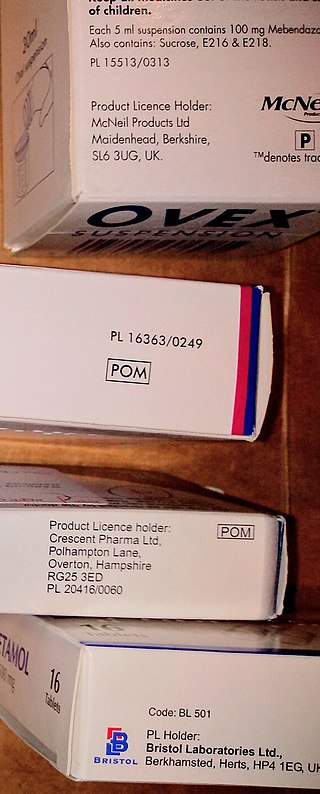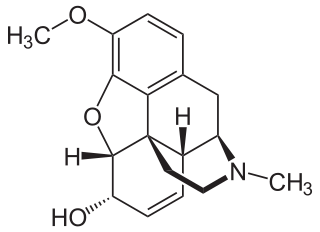Related Research Articles

The Controlled Substances Act (CSA) is the statute establishing federal U.S. drug policy under which the manufacture, importation, possession, use, and distribution of certain substances is regulated. It was passed by the 91st United States Congress as Title II of the Comprehensive Drug Abuse Prevention and Control Act of 1970 and signed into law by President Richard Nixon. The Act also served as the national implementing legislation for the Single Convention on Narcotic Drugs.

Pseudoephedrine (PSE) is a sympathomimetic drug of the phenethylamine and amphetamine chemical classes. It may be used as a nasal/sinus decongestant, as a stimulant, or as a wakefulness-promoting agent in higher doses.

Over-the-counter (OTC) drugs are medicines sold directly to a consumer without a requirement for a prescription from a healthcare professional, as opposed to prescription drugs, which may be supplied only to consumers possessing a valid prescription. In many countries, OTC drugs are selected by a regulatory agency to ensure that they contain ingredients that are safe and effective when used without a physician's care. OTC drugs are usually regulated according to their active pharmaceutical ingredient (API) rather than final products. By regulating APIs instead of specific drug formulations, governments allow manufacturers the freedom to formulate ingredients, or combinations of ingredients, into proprietary mixtures.

A prescription drug is a pharmaceutical drug that is permitted to be dispensed only to those with a medical prescription. In contrast, over-the-counter drugs can be obtained without a prescription. The reason for this difference in substance control is the potential scope of misuse, from drug abuse to practicing medicine without a license and without sufficient education. Different jurisdictions have different definitions of what constitutes a prescription drug.

Dihydrocodeine is a semi-synthetic opioid analgesic prescribed for pain or severe dyspnea, or as an antitussive, either alone or compounded with paracetamol (acetaminophen) or aspirin. It was developed in Germany in 1908 and first marketed in 1911.

The regulation of therapeutic goods, defined as drugs and therapeutic devices, varies by jurisdiction. In some countries, such as the United States, they are regulated at the national level by a single agency. In other jurisdictions they are regulated at the state level, or at both state and national levels by various bodies, as in Australia.

The United States Federal Food, Drug, and Cosmetic Act is a set of laws passed by the United States Congress in 1938 giving authority to the U.S. Food and Drug Administration (FDA) to oversee the safety of food, drugs, medical devices, and cosmetics. A principal author of this law was Royal S. Copeland, a three-term U.S. senator from New York. In 1968, the Electronic Product Radiation Control provisions were added to the FD&C. Also in that year the FDA formed the Drug Efficacy Study Implementation (DESI) to incorporate into FD&C regulations the recommendations from a National Academy of Sciences investigation of effectiveness of previously marketed drugs. The act has been amended many times, most recently to add requirements about bioterrorism preparations.

The Standard for the Uniform Scheduling of Medicines and Poisons (SUSMP) is an Australian legislative instrument produced by the Therapeutic Goods Administration (TGA). Before 2010, it was known as the Standard for the Uniform Scheduling of Drugs and Poisons (SUSDP). The SUSMP classifies drugs and poisons into different Schedules signifying the degree of control recommended to be exercised over their availability to the public. As of 2023, the most recent version is the Therapeutic Goods Instrument 2023.
A controlled substance is generally a drug or chemical whose manufacture, possession and use is regulated by a government, such as illicitly used drugs or prescription medications that are designated by law. Some treaties, notably the Single Convention on Narcotic Drugs, the Convention on Psychotropic Substances, and the United Nations Convention Against Illicit Traffic in Narcotic Drugs and Psychotropic Substances, provide internationally agreed-upon "schedules" of controlled substances, which have been incorporated into national laws; however, national laws usually significantly expand on these international conventions.
An online pharmacy, internet pharmacy, or mail-order pharmacy is a pharmacy that operates over the Internet and sends orders to customers through mail, shipping companies, or online pharmacy web portal.

In the field of pharmacy, compounding is preparation of a custom medication to fit a unique need of a patient that cannot be met with commercially available products. This may be done for medical reasons, such as administration in a different format, to avoid a non-active ingredient the patient is allergic to, or to provide an exact dose that isn't commercially available. Patient-specific compounding according to a prescriber's specifications is referred to as "traditional" compounding. The nature of patient need for such customization can range from absolute necessity to individual optimality to even preference.

Codeine is an opiate and prodrug of morphine mainly used to treat pain, coughing, and diarrhea. It is also commonly used as a recreational drug. It is found naturally in the sap of the opium poppy, Papaver somniferum. It is typically used to treat mild to moderate degrees of pain. Greater benefit may occur when combined with paracetamol (acetaminophen) or a nonsteroidal anti-inflammatory drug (NSAID) such as aspirin or ibuprofen. Evidence does not support its use for acute cough suppression in children or adults. In Europe, it is not recommended as a cough medicine in those under 12 years of age. It is generally taken by mouth. It typically starts working after half an hour, with maximum effect at two hours. Its effects last for about four to six hours. Codeine exhibits abuse potential similar to other opioid medications.

Tapentadol, brand names Nucynta among others, is a centrally acting opioid analgesic of the benzenoid class with a dual mode of action as an agonist of the μ-opioid receptor and as a norepinephrine reuptake inhibitor (NRI). Analgesia occurs within 32 minutes of oral administration, and lasts for 4–6 hours.
The legal status of unauthorised actions with psilocybin mushrooms varies worldwide. Psilocybin and psilocin are listed as Schedule I drugs under the United Nations 1971 Convention on Psychotropic Substances. Schedule I drugs are defined as drugs with a high potential for abuse or drugs that have no recognized medical uses. However, psilocybin mushrooms have had numerous medicinal and religious uses in dozens of cultures throughout history and have a significantly lower potential for abuse than other Schedule I drugs.
Schedule H is a class of prescription drugs in India appearing as an appendix to the Drugs and Cosmetics Rules, 1945 introduced in 1945. These are drugs which cannot be purchased over the counter without the prescription of a qualified doctor. The manufacture and sales of all drugs are covered under the Drugs and Cosmetics Act and Rules. It is revised at times based on the advice of the Drugs Technical Advisory Board, part of the Central Drugs Standard Control Organization in the Ministry of Health and Family Welfare. The most recent schedule H (2006) lists 536 drugs from abacavir to zuclopenthixol.
Drugs Controller General of India (DCGI) is the head of department of the Central Drugs Standard Control Organization of the Government of India responsible for approval of licences of specified categories of drugs such as blood and blood products, IV fluids, vaccines, and sera in India. Drugs Controller General of India, comes under the Ministry of Health & Family Welfare. DCGI also sets standards for manufacturing, sales, import, and distribution of drugs in India.

The Central Drugs Standard Control Organisation (CDSCO) is India's national regulatory body for cosmetics, pharmaceuticals and medical devices. It serves a similar function to the European Medicines Agency of the European Union, the PMDA of Japan, the Food and Drug Administration (FDA) of the United States, and the Medicines and Healthcare products Regulatory Agency of the United Kingdom, and the State Administration for Market Regulation of China. The Indian government has announced its plan to bring all medical devices, including implants and contraceptives under a review of the Central Drugs and Standard Control Organisation (CDSCO).

The Drugs and Cosmetics Act, 1940 is an act of the Parliament of India which regulates the import, manufacture and distribution of drugs in India. The primary objective of the act is to ensure that the drugs and cosmetics sold in India are safe, effective and conform to state quality standards. The related Drugs and Cosmetics Rules, 1945 contains provisions for classification of drugs under given schedules and there are guidelines for the storage, sale, display and prescription of each schedule.
Online pharmacy laws in India are still in nascent stage and there are no dedicated online pharmacy laws in India. The Information Technology Act 2000 governs some of the legal issues pertaining to online dealings but it is silent on the aspect of online pharmacy. As a result, illegal online pharmacies have been increasing in India. It has been said that, if properly regulated, online pharmacies in India could prove beneficial to various stakeholders.
The Drugs and Cosmetics Rules, 1940 are the rules which the government of India established through the Drugs and Cosmetics Act, 1940. These rules classify drugs under given schedules and present guidelines for the storage, sale, display and prescription of each schedule.
References
- ↑ Government of India (2011). "National Formulary of India, 4th Edition, 2011" (PDF). cdsco.nic.in. Archived from the original (PDF) on 2019-02-14. Retrieved 2019-02-17.
- ↑ Kamboj, Ajay (2016-03-10). "Schedule X:List of drugs". Pharma Franchise Help. Retrieved 2019-02-17.
- ↑ Government of India (December 31, 2016). "THE DRUGS AND COSMETICS ACT AND RULES" (PDF). cdsco.nic.in. Retrieved 2019-02-17.
- ↑ "Archived copy" (PDF). Archived from the original (PDF) on 2010-11-23. Retrieved 2014-11-03.
{{cite web}}: CS1 maint: archived copy as title (link)